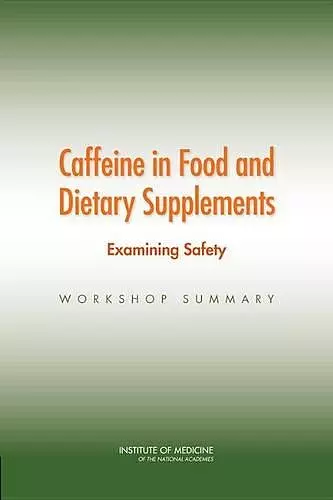Caffeine in Food and Dietary Supplements
Examining Safety: Workshop Summary
Institute of Medicine author Board on Health Sciences Policy author Food and Nutrition Board author Planning Committee for a Workshop on Potential Health Hazards Associated with Consumption of Caffeine in Food and Dietary Supplements author Ann L Yaktine editor Leslie Pray editor Diana Pankevich editor
Format:Paperback
Publisher:National Academies Press
Published:23rd May '14
Currently unavailable, and unfortunately no date known when it will be back

Caffeine in Food and Dietary Supplements is the summary of a workshop convened by the Institute of Medicine in August 2013 to review the available science on safe levels of caffeine consumption in foods, beverages, and dietary supplements and to identify data gaps. Scientists with expertise in food safety, nutrition, pharmacology, psychology, toxicology, and related disciplines; medical professionals with pediatric and adult patient experience in cardiology, neurology, and psychiatry; public health professionals; food industry representatives; regulatory experts; and consumer advocates discussed the safety of caffeine in food and dietary supplements, including, but not limited to, caffeinated beverage products, and identified data gaps.
Caffeine, a central nervous stimulant, is arguably the most frequently ingested pharmacologically active substance in the world. Occurring naturally in more than 60 plants, including coffee beans, tea leaves, cola nuts and cocoa pods, caffeine has been part of innumerable cultures for centuries. But the caffeine-in-food landscape is changing. There are an array of new caffeine-containing energy products, from waffles to sunflower seeds, jelly beans to syrup, even bottled water, entering the marketplace. Years of scientific research have shown that moderate consumption by healthy adults of products containing naturally-occurring caffeine is not associated with adverse health effects. The changing caffeine landscape raises concerns about safety and whether any of these new products might be targeting populations not normally associated with caffeine consumption, namely children and adolescents, and whether caffeine poses a greater health risk to those populations than it does for healthy adults. This report delineates vulnerable populations who may be at risk from caffeine exposure; describes caffeine exposure and risk of cardiovascular and other health effects on vulnerable populations, including additive effects with other ingredients and effects related to pre-existing conditions; explores safe caffeine exposure levels for general and vulnerable populations; and identifies data gaps on caffeine stimulant effects.
Table of Contents- Front Matter
- 1 Introduction
- 2 Intake and Exposure to Caffeine
- 3 Safety Signals and Surveillance
- 4 Exploring Safe Caffeine Exposure Levels for Vulnerable Populations
- 5 Caffeine Effects on the Cardiovascular System
- 6 Caffeine Effects on the Central Nervous System and Behavioral Effects Associated with Caffeine Consumption
- 7 Other Compounds Impacting Caffeine Effects
- 8 Public Comments
- 9 Moving Forward: Filling the Data Gaps
- Appendix A: Workshop Agenda
- Appendix B: Workshop Attendees
- Appendix C: Biographical Sketches of Workshop Speakers and Moderators
- Appendix D: Workshop Statement...
ISBN: 9780309297493
Dimensions: unknown
Weight: unknown
212 pages